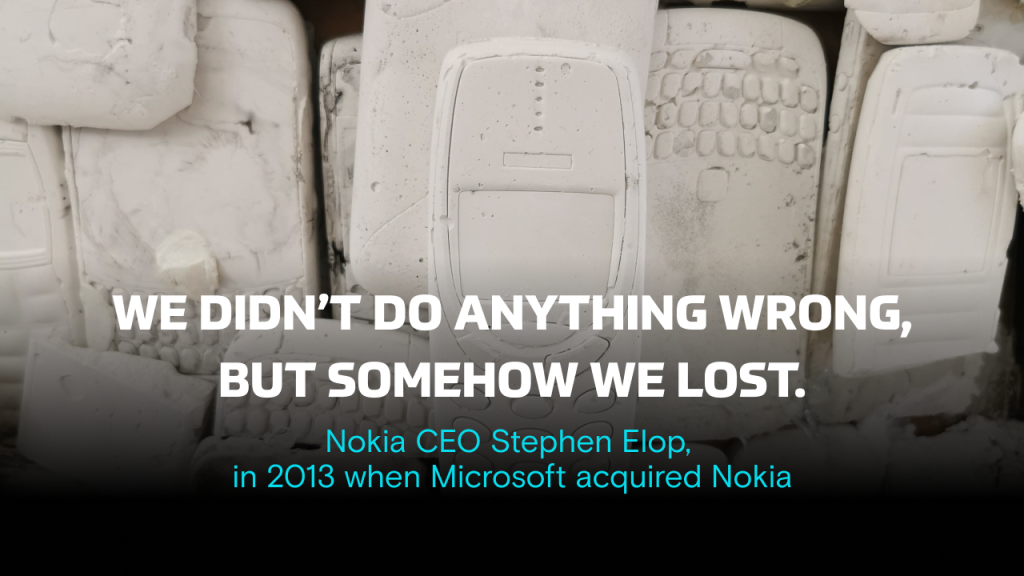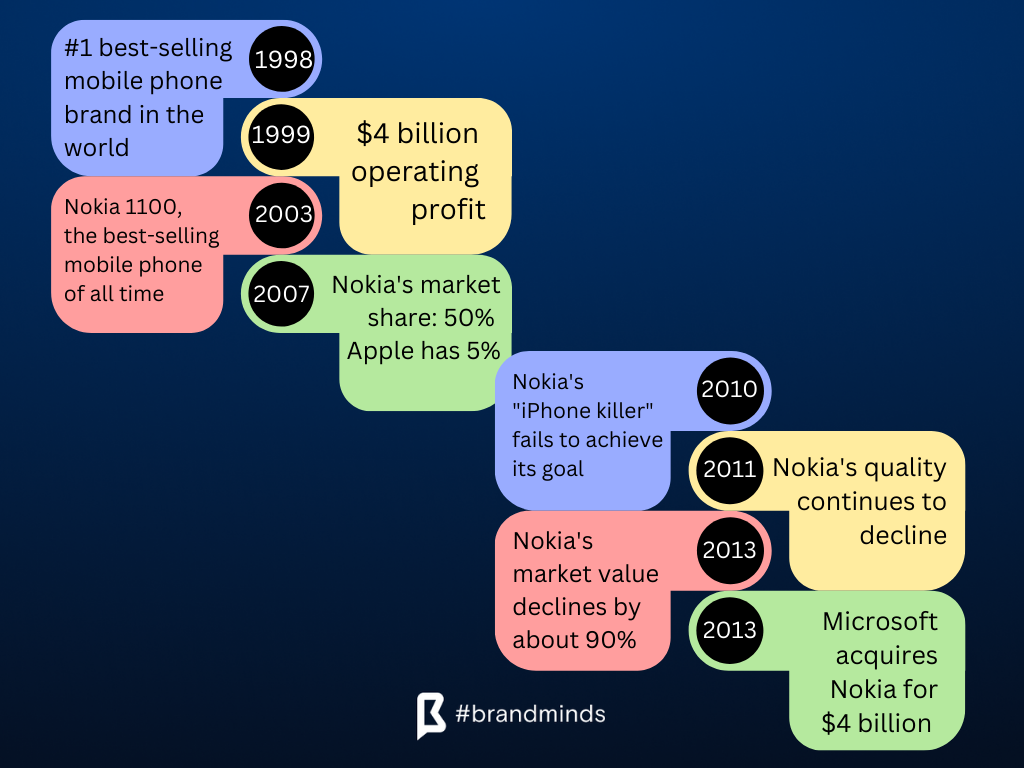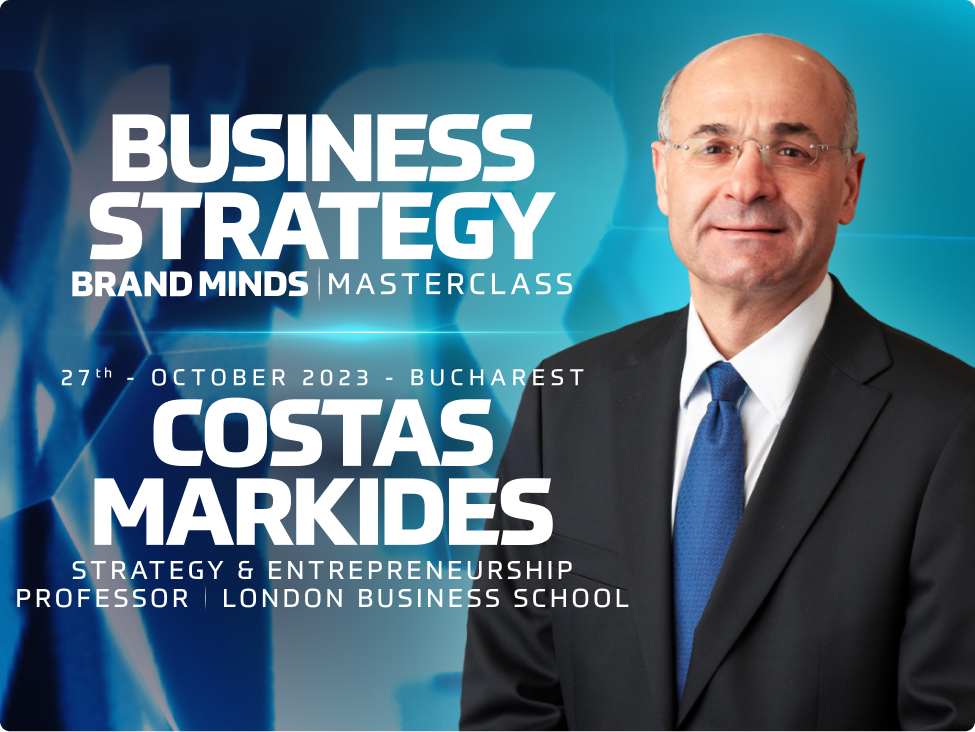McKinsey 7S model of Nokia – where the company went wrong
From a cell phone pioneer to being acquired by Microsoft in 2013, Nokia is a case study of organizational failure. Let’s analyze where the company went wrong by applying McKinsey 7S model.
McKinsey 7S model is a business framework which can be used to analyze organizational effectiveness. According to the McKinsey model, the organization is a complex ecosystem consisting of seven interconnected factors: Structure, Strategy, Skills, Staff, Systems, Style and Shared Values.
The model is also a blueprint for organizational change.
To show you how you can use the McKinsey model 7S for the benefit of your organization, I will analyze mobile pioneer Nokia at the time of its demise, namely 2011-2013.
Here’s a brief background story:
In October 1998, Nokia became the best-selling mobile phone brand in the world with an operating profit of almost $4 billion. The best-selling mobile phone of all time, the Nokia 1100, was created in 2003. Five years later, Apple introduced the iPhone. By the end of 2007, half of all smartphones sold in the world were Nokias, while Apple’s iPhone had a mere 5% share of the global market.
In 2010, attempting to drive Apple out of the market, Nokia launched the “iPhone killer”. The model failed to achieve its goal and was the beginning of the end for Nokia. From that moment on, Nokia embarked on a downward spiral of low-quality phones. In just six years, the market value of Nokia declined by about 90%. The organization was acquired by Microsoft in 2013.
Now that you’re familiar with Nokia’s failure story, let’s analyze the organization before Microsoft made its move to acquire it by applying the McKinsey 7S model.
In my opinion, here are the factors that required immediate change: Structure, Style, Skills, Staff and Strategy.
McKinsey 7S model of Nokia
McKinsey 7S model of Nokia – Structure
Nokia of the era was a top-down line structure organization.
In public speeches given by the organization’s top executives, agility and being nimble were mentioned as key competitive advantages.
But it was all talk. The organization’s top management was living in a bubble, disconnected from the company’s technology development departments. Communication was one-way and teams were not empowered to contribute to the organization’s strategy.
To adapt to the new technological environment and compete with Apple, a powerful tech company, Nokia should have taken steps to change its structure from top-down hierarchical to decentralized and agile.

Instead of organizing employees in silos, with no communication and collaboration between them, the company should have placed its employees in teams, with every team working to achieve a common goal.
Team members should have been empowered to speak up, come up with solutions and work independently.
McKinsey 7S Model of Nokia – Style
In McKinsey’s model style refers to culture. What was Nokia’s culture at that time?
As per the 2015 paper Distributed Attention and Shared Emotions in the Innovation Process: How Nokia Lost the Smartphone Battle, Nokia suffered from organizational fear, status (We are no 1), in-house politics and temporal myopia.
Top managers had business backgrounds and lacked technological competence. Employee morale was low.
As the saying goes, culture eats strategy for breakfast. Top management should have adopted a transformational leadership style where the leader’s goal is to transform the organization so that it’s constantly improving.
Transformational leaders create a vision of the future that they share with their teams so that everyone can work together toward a shared goal and vision. Technology is ever-changing. Technology companies must embrace change in order to stand the test of time.
Transformational leadership would have been the best fit for Nokia because it fosters creativity and innovation through collaboration. This type of culture builds and maintains employee motivation and satisfaction and is effective in facilitating organizational change.
McKinsey 7S Model of Nokia – Skills
Nokia didn’t lack talent and didn’t have a skills gap in the company. There were no gaps in know-how or competence.
At its peak, Nokia had one of the top highly-skilled tech workforces in the world.
The company’s hardware and software engineers had designed one of the most successful and iconic cell phones in the world, there’s no doubt about it.
The problem was the top management. Between 2007 and 2010, the position of the Chief Technology Officer (CTO) disappeared from the top management team. Technical managers had left the company and new hires had no technical skills making it difficult for them to understand the technological challenges and the direction in which the company should be heading.
Conversely, top management members at Apple were all engineers. Nokia should have focused on increasing tech skills among C-level executives.
McKinsey 7S Model of Nokia – Staff
At Nokia, people were talking business instead of technology which is quite surprising for a software company.
The organization should have found ways to motivate and nurture its employees appropriately.
McKinsey 7S Model of Nokia – Strategy
Struggling to compete with Apple and adapt to the technological developments that were disrupting the business environment at that time, Nokia top management had to choose between three strategies: optimizing costs and volume, maximizing performance, or maximizing security.
They decided to go with cost optimization which made it impossible to achieve performance in software.
With Apple going for technological innovations and excellency, needless to say, they made the wrong decision.
Conclusion
At its peak, Nokia manufactured 40% of the world’s mobiles. The company had the human resources (skills and staff factors) required to keep innovating and increasing its market share.
Unfortunately, the company’s leadership (style factor) lacked core competences and vision necessary to drive change within the company.
They didn’t allow the tech talent in the company to contribute with valuable insights to important decisions. The company chose the wrong strategy which ultimately lead to its demise.
Join the Conversation
We’d love to hear what you have to say.
Get in touch with us on our LinkedIn Page, Facebook Page, Twitter or TikTok.
Nokia’s failure: what was their biggest mistake?
Nokia’s failure became official when the company was acquired by Microsoft, in 2013. At the time, Nokia’s CEO Stephen Elop famously said:

This article presents one of Nokia’s reasons for failure and what you can learn to improve your leadership.
A concise timeline of Nokia’s important moments:
- In October 1998, Nokia became the best-selling mobile phone brand in the world;
- Nokia’s operating profit went from $1 billion in 1995 to almost $4 billion by 1999;
- The best-selling mobile phone of all time, the Nokia 1100, was created in 2003;
- In 2007, Apple introduced the iPhone;
- By the end of 2007, half of all smartphones sold in the world were Nokias, while Apple’s iPhone had a mere 5% share of the global market;
- In 2010 Nokia launched the “iPhone Killer” but failed to match the competition;
- The quality of Nokia’s high-end phones continues to decline;
- In just six years, the market value of Nokia declined by about 90%;
- Nokia’s decline accelerates by 2011 and is acquired by Microsoft in 2013.

Nokia’s failure from being the world’s best mobile phone company to losing it all by 2013 has become a case study discussed by teachers and students in business management classes.
When explaining Nokia’s failure many observers found 3 reasons:
- Nokia’s technology was inferior to Apple’s;
- The arrogance among top-level managers;
- Lack of vision.
In order to understand its rapid downfall from its position as a world-dominant and innovative technology organisation, Timo Vuori, a Strategy Professor at Aalto University and Qui Huy, a Professor of Strategy at INSEAD Singapore conducted a qualitative study.
The results were published in the 2015 paper Distributed Attention and Shared Emotions in the Innovation Process: How Nokia Lost the Smartphone Battle.
The study consisted of interviewing 76 Nokia top and middle managers, engineers and external experts and conducting in-depth investigations.
Here are Mr Huy’s and Mr Vuori’s key findings:
- At that time Nokia suffered from organisational fear;
- The organisational fear was grounded in a culture of temperamental leaders and frightened middle managers;
- The middle management was scared of telling the truth because they feared being fired;
- Top managers were afraid of the external environment and not meeting their quarterly targets;
- Executives were afraid to publicly acknowledge the inferiority of Symbian, Nokia’s operating system;
- They knew it would take several years to develop a better operating system that could compete with Apple’s iOS;
- Top executives were afraid of losing investors, suppliers and customers if they acknowledged their technological inferiority to Apple;
- Top managers intimidated middle managers by accusing them of not being ambitious enough to meet their goals;
- Top management was lied to by middle management who felt it was useless to tell the truth;
- Top managers lacked technical competence which influenced how they could assess technological limitations during goal setting; by comparison, the top engineers at Apple were all engineers;
- Instead of allocating resources to the achievement of long-term goals such as developing a new operating system, Nokia’s management decided to develop new phone devices for short-term market demands.
The experts’ conclusion regarding Nokia’s biggest mistake preventing it to adapt and compete is this:
Nokia’s ultimate fall can be put down to internal politics.
In short, Nokia people weakened Nokia people and thus made the company increasingly vulnerable to competitive forces. When fear permeated all levels, the lower rungs of the organisation turned inward to protect resources, themselves and their units, giving little away, fearing harm to their personal careers. Top managers failed to motivate the middle managers with their heavy-handed approaches and they were in the dark with what was really going on.
Key Takeaways from Nokia’s failure case study
- Nokia’s culture of status has led to an atmosphere of shared fear which influenced how employees were interacting with each other.
- The human factor was added to economic and structural factors and together they generated a state of “temporal myopia” that hindered Nokia’s ability to innovate.
- Employees stated that top managers and directors were no longer abiding by Nokia’s core values of Respect, Challenge, Achievement and Renewal.
- This study points out the paramount importance of shared emotions among employees and their powerful impact on the company’s competitiveness.
What should leaders learn from Nokia’s failure?
- Leaders should maintain a close connection with their employees and be aware of their emotions and state of mind;
- Operating with the old mindset does not help their companies adapt to the future and the many challenges it brings (industry disruptions, customer behaviour changes, the rise of new digital platforms, competition from small agile startups);
- Having the power to constantly challenge the status quo allows leaders and their organisations to embrace a culture of change;
- Transformational leadership style is mandatory, and the policy of closed doors must be eliminated – the innovation process should be encouraged at all levels but for this leaders have to learn again how to properly listen to their employees, customers and partners;
- Before being able to understand their employees’ emotions, leaders must become more mindful (read How mindfulness can help you become a better leader). Emotional intelligence is not just a nice-to-have soft skill – it is mandatory, especially when at the decision table leaders will have a mix of generations including Millennials and Z;
- To master the power of taking responsibility for bad decisions, failed innovation, and lost market share despite the danger of losing their status, role, and bonuses. Learning fast from failures or from other companies’ failures helps leaders mitigate risks and design better services & products;
- Middle managers need more courage to challenge the CEO or Sr. Leadership for the benefit of the whole organisation and to accomplish this HR should act as a real business partner and mitigator.
Microsoft learned from Nokia’s failure and changed its culture so it doesn’t have the same fate
In 2014, Satya Nadella became the current CEO of Microsoft, following Bill Gates and Steve Ballmer.
The most important change that Satya brought to Microsoft was shifting the company’s culture. He says that his job as CEO is to create a culture that focuses on listening, learning, and harnessing individual passions and talents. Satya also placed employer empowerment at the core of Microsoft’s culture.
Company culture is not to be taken lightly. In fact company culture is a major factor contributing to the company’s development and ability to compete and be successful.
Company culture starts at the top and grows at the bottom. It includes mission, values, environment, ethics, expectations, overall mood, goals etc. But unless the company’s leadership fully embraces them, they are just beautiful but empty words.
Interested in learning more about Nokia’s failure? Read Where Nokia went wrong – a McKinsey 7S Model Analysis.
Looking to grow your business? Learn how from Costas Markides, Professor of Strategy & Entrepreneurship at London Business School, on October 27, at the BUSINESS STRATEGY MASTERCLASS.

5 things you might not know about Julian Treasure
With regularly appearances in the world’s media (TIME Magazine, The Times, The Economist, BBC, etc), Julian Treasure is also famous for his books How to be Heard and Sound Business.
- His TED talks on conscious listening and powerful speaking have collectively been viewed almost 50 million times; they are respectively the 95th and 8th most-watched TED talks of all time.
2. At the Sound Agency, him and his team help clients such as Harrods, Nokia, BP, Marks & Spencer, Helm Bank, Waldorf Astoria and many major shopping centers across Europe to grow their business by optimizing the sounds they make to increase sales, customer satisfaction, staff productivity and brand value. The agency specializes in creating effective and appropriate organic soundscapes for branded spaces.
3. He has a Bachelor degree in Economics, from the University of Cambridge, UK.
4. Julian’s love of sound stems from his early experience as a musician. He was a drummer for British band The Transmitters, amongst many others, and played on their second Peel Session in 1981.

5. Before The Sound Agency, Julian spent 30 years working in advertising and publishing. He founded, grew and sold contract magazine publishing agency TPD. Nowadays, Julian splits his time between London and Orkney, where he lives with his fiancee and youngest daughter.